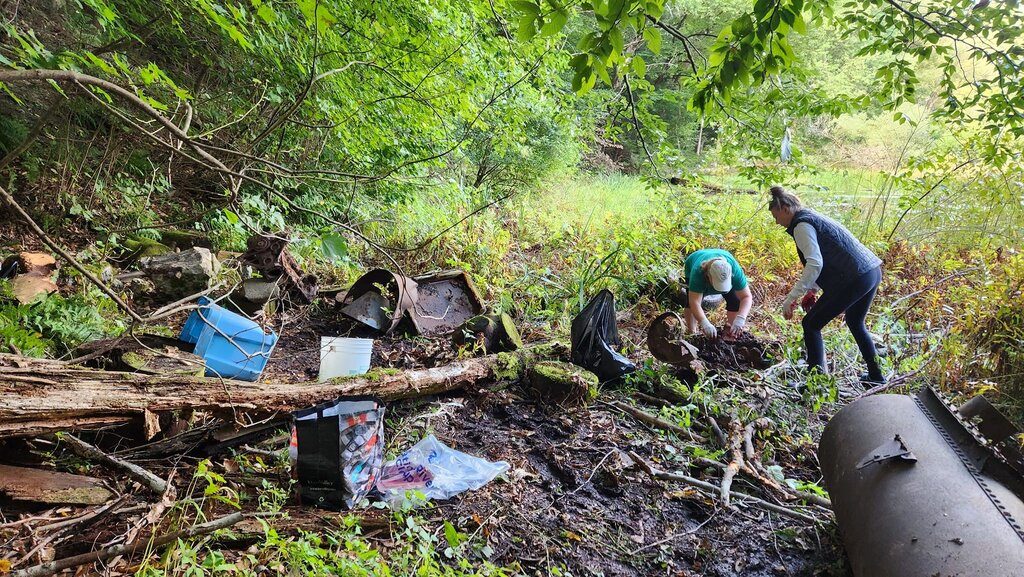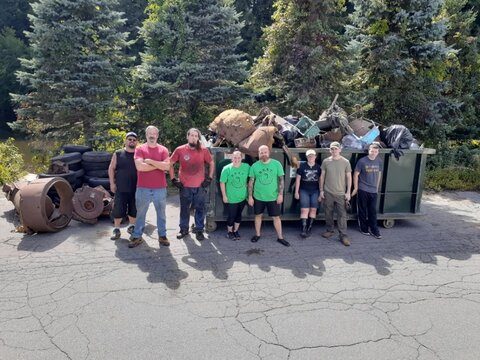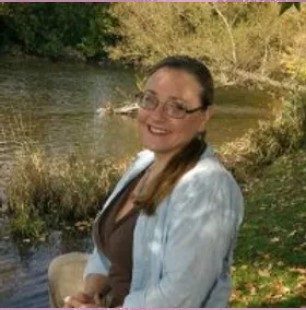What began as a one-time cleanup of the Black River in southeastern Vermont has evolved into a volunteer-driven, watershed organization of more than 23 years standing. Shaw’s has supported Black River Action Team through the GIVE BACK WHERE IT COUNTS Reusable Bag Program.
Tell us about Black River Action Team.
The start of the Black River Action Team (BRAT) is my favorite story; it’s kind of my superhero origin story. Back in 2000, my husband and I had just moved to Springfield, Vermont, and went for a little walk with our toddler daughter. As we crossed a bridge, I peeked over the railing to see if I could spot a fish, turtle, duck or anything. When I was a kid, I spent a lot of time hanging out in nature with my dad to just Zen out, so I was hoping to find something nice in the river.
It’s just a matter of deciding to be that somebody.
Instead, there were shopping carts, tires, cement bricks and junk. I remember saying loudly, “Somebody should do something about that junk!” My husband elbowed me in the ribs and replied, “Well, you’re ‘somebody’!” That fall, I got some co-workers to join me, my husband and my daughter to clean up that little section of the Black River. It took us a few hours to pull all that junk out, but we did it, and it felt great. That’s how we started, and when I say we, I mean me and whatever volunteers I can pull together. That first cleanup has become The RiverSweep cleanup and my signature event. It’s scheduled annually on the Saturday after Labor Day weekend.
You don’t have to develop a board of directors with a 10-year budget and apply for 300 grants. You can contact a few partners, get some trash bags and work gloves, and get started. It might be a one-off project, or it could develop into something a lot bigger. It’s just a matter of deciding to be that somebody.
If we get to know the river through service projects, citizen science and paddling excursions, we’ll care more about keeping the waters clean, healthy and thriving.
The mission has been to connect people to the river meaningfully. We do hands-on, pragmatic work, rolling up our sleeves and doing projects that have long-term effects. If we get to know the river through service projects, citizen science and paddling excursions, we’ll care more about keeping the waters clean, healthy and thriving. I firmly believe that ecological health goes hand in hand with economic health!

What services do you provide to the community?
Through the Black River Action Team, I can provide opportunities for everyone to get involved in protecting, improving and learning about the river and the land it runs through.
The annual RiverSweep cleanup now spreads over several days and throughout the whole watershed, about 202 square miles of Windsor County. Schools come and help on different days, and we’ve got a Green Up Day activity that goes on as well.
We all must work together and realize that the human economy is a big part of the river’s ecological health.
We also conduct water quality monitoring, invasive species management and manage aquatic and terrestrial plants. We do native tree plantings to help stabilize shorelines and riverbanks. And, something relatively new in the last few years, we perform dragonfly surveys. Monitoring and surveys are related to water quality and habitat. The river’s ecology needs to be protected and improved, but that goes hand in hand with economic health and vibrancy. Nobody wants to buy lakefront property if the lake is choked with invasive plants and has a bunch of nitrogen, phosphorus, runoff and dead fish. It improves if people invest time and money, benefiting from its recreation and scenic appeal.
We all must work together and realize that the human economy is a big part of the river’s ecological health. Getting that message out to the community is a big part of the Black River Action Team’s services.
What sets your organization apart from other nonprofits in your community?
The Black River Action Team has grassroots connectivity that really tries to engage with students and families throughout our community. I also reach out to not just local public schools but also to the homeschool community. We get families and kids engaged in doing projects with their parents and learning about dragonflies, water quality and why we must plant native trees.
I like to engage the whole family unit. We educate on much of the river’s ecology, from what plants are invasive to how to test the water quality. I connect the community to the river in creative ways.
Tell us a story that illustrates your organization’s good work.
I’m excited that BRAT is in its third year of managing the invasive Phragmites reed on Amherst Lake. The Phragmites reed is also known as the Common Reed. This plant grows tall and in dense stands, blocking sunlight and clogging waterways from fish travel. The invasive Phragmites reed looks like a skinny corn stalk. It encroaches and changes the hydrology of the shoreline. This reed gets so thick and dense that it doesn’t allow anything else to grow. These tall compact thickets get big plumes that look like corn silk on their tops in late summer, blocking any sunlight to native plants below. We have a significant infestation on Route 100 at the top of Plymouth, Vermont, where the Black River is still a broad stream and goes into some beaver wetlands. In my words, I’m working on “’Dephragging’ Amherst Lake.”

We are cutting the reed down, removing the stalk and digging to sever the roots that are down in the mud. Then, in partnership with the state of Vermont’s Wetlands Program, we cover the cleared areas with tarps. We tarp and weigh them down, so the root below starves out and allows the native plants to grow. Before and after the “Dephragging,” we do a shoreline vegetation survey, which is exciting and will have very visible results. This is an ongoing project that will likely continue for several more years to come.
What is your most outstanding achievement or contribution to the community?
It’s hard to pick just one. Over 23 years, I’ve had many volunteers bring so much to the table. When I put out a call for help, and people show up, it is terrific. The most awe-inspiring project that blew my mind was the beginning of the large-scale trash cleanup.
I call it a “legacy trash site” in Springfield, Vermont. Every community back in the ’60s and ’70s had this out-of-sight, out-of-mind mentality. If you had a broken sofa and needed to get rid of it, a bunch of old tires or bags of household trash and kids’ toys, they ended up over the edge of your property, often down a riverbank. The thought was that it’s not there if we can’t see it and will eventually get covered in branches and leaves. Well, the garbage is still there!

The first cleanup took several months to put the logistics and partners together. Because the river covers several acres of land, I worked with the town of Springfield and property owners across the river and the state of Vermont because the river is state property. A local veteran-owned landscape company did targeted clearing for us. It was terrific; they set up the rigging and only cut down branches that were in the way of the volunteers cleaning. They marked things with spray paint to prevent tripping; they staged the whole area to make the cleanup productive and as easy as possible.
I had a dedicated core of volunteers do a solid six hours of heavy-duty hauling. It involved scaling steep slopes and transporting boatloads of junk, heavy metal, tires and bags upon bags of trash across the river to a massive dumpster. It was hard but impactful work. Improving the quality of our community so it’s a nicer place to live is a large part of what we do. This site is more than an acre in size, so phase two should be happening this May during the Green Up Day!
What do you want people to know about Black River Action Team?
Since I started in 2000, the Black River Action Team has been volunteer-driven. It’s fueled entirely by donated elbow grease. Time and money are all donated; there’s no paid staff. I do this in my spare time.
Anything that people can do to help is so appreciated. Whether it is a monetary donation or they can spare a couple of hours once a week, people of all ages can get involved in a wide range of ways.
How are you using the funds you’ve received from the Shaw’s GIVE BACK WHERE IT COUNTS Reusable Bag Program?
These funds will help the Amherst Lake project this summer. It was a great moment recently when I got the information about the check coming from Shaw’s GIVE BACK WHERE IT COUNTS Reusable Bag Program. I knew I would put that right toward a tarp for the “Dephragging” efforts. All donations go into the many projects we do in the river.
I really thank Shaw’s for having such a cool program. It’s fantastic to know the managers of the Ludlow store nominated BRAT to be their recipient. And, a huge thanks to all who purchased a bag or two to help support the work of the Black River Action Team.
Is there anything you would like to add?
I urge everyone to reach out and ask how to get involved in BRAT! There are lots of ways that people can help, whether you have a little or a lot of time to give, whether you like to use a shovel or trash bag or a computer or camera. Please visit our website at www.blackrivercleanup.com if you have any questions

Published February 28, 2023.

